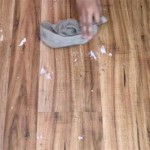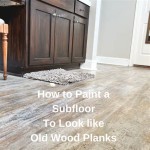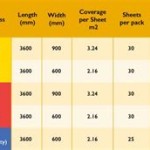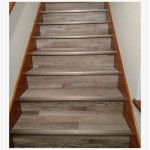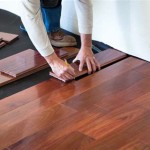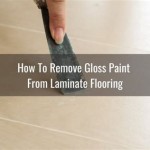How To Remove Sticky Residue From Floors
Sticky residue on floors is a common household nuisance, often resulting from spills, adhesives, dropped food items, or tracked-in materials. This unsightly and often unsanitary condition can detract from the overall appearance of a home or office and, if left unattended, can attract more dirt and debris, exacerbating the problem. Addressing sticky residue requires understanding the type of residue, the type of flooring, and the appropriate cleaning methods to avoid damaging the surface.
The methods employed for removing sticky substances from floors vary depending on several factors. Identifying the source of the residue is crucial, as different substances require different solvents or cleaning agents. For instance, adhesive residue from tape or stickers may necessitate a solvent-based approach, while sugary spills might respond well to warm water and gentle detergents. The flooring material is equally important. Hardwood floors require different care compared to tile, laminate, or vinyl, each with varying levels of sensitivity to moisture and abrasive cleaners.
This article provides a comprehensive guide to removing sticky residue from various types of floors, focusing on effective techniques and preventative measures to maintain clean and residue-free surfaces.
Identifying the Sticky Residue and Flooring Type
Before commencing any cleaning procedure, a thorough assessment of both the sticky residue and the flooring material is essential. Incorrect identification can lead to ineffective cleaning or, worse, damage to the floor. Begin by determining the origin of the residue. Consider recent activities that might have caused the mess, such as crafting projects involving glue, food preparation accidents, or shoe marks from outdoor excursions.
Common types of sticky residue include adhesive from tape, stickers, or labels; dried food or beverage spills, such as syrup, juice, or soda; grease and oil from cooking; and tracked-in substances like gum, tar, or mud. The consistency and appearance of the residue can offer clues to its source. For example, a clear, slightly hardened residue may indicate dried glue, while a dark, oily residue might suggest grease or tar.
Simultaneously, identify the type of flooring. Typical residential and commercial flooring options include hardwood, tile (ceramic, porcelain, or stone), laminate, vinyl (sheet vinyl, vinyl tile, or luxury vinyl plank), and concrete. Each material possesses distinct properties and vulnerabilities that impact the choice of cleaning methods. Hardwood is susceptible to water damage and scratches, while tile is more durable but can be stained by certain chemicals. Laminate is relatively water-resistant but can be damaged by harsh abrasives. Vinyl is generally water-resistant and easy to clean, but susceptible to discoloration from strong solvents. Concrete can be porous and may require specialized sealers and cleaning agents.
Once the residue and flooring type are identified, appropriate cleaning methods can be selected. Performing a spot test in an inconspicuous area is always recommended to ensure the chosen cleaning agent does not damage or discolor the flooring.
Effective Cleaning Methods for Different Flooring Types
After identifying the type of residue and flooring, the appropriate cleaning method can be implemented. This section outlines specific techniques for various flooring types, prioritizing gentle and effective solutions.
Hardwood Floors: Hardwood floors are sensitive to moisture and abrasive cleaners. For sticky residue removal, start with a dry method. Gently scrape off any loose residue with a plastic scraper or a dull knife, being careful not to scratch the wood. Avoid using metal tools. Next, dampen a soft cloth with warm water and a mild dish soap. Wring out the cloth thoroughly to prevent excessive moisture. Gently wipe the affected area, focusing on lifting the residue rather than scrubbing aggressively. For more stubborn residue, consider using a specialized hardwood floor cleaner designed to remove sticky substances. Always follow the manufacturer's instructions. After cleaning, dry the area immediately with a clean, dry cloth to prevent water damage. For adhesive residue, mineral spirits (following safety precautions, including ventilation) can be used sparingly on a cloth, followed by thorough cleaning with soap and water and immediate drying.
Tile Floors: Tile floors, including ceramic, porcelain, and stone, are generally more durable than hardwood but can still be damaged by harsh chemicals or abrasive cleaners. For removing sticky residue from tile, start by sweeping or vacuuming the area to remove any loose debris. Then, mix warm water with a mild dish soap or a specialized tile cleaner. Apply the solution to the affected area and let it sit for a few minutes to soften the residue. Use a soft brush or sponge to scrub the area gently. For grout lines, a grout brush may be necessary. Rinse the area thoroughly with clean water and dry with a clean cloth. For stubborn stains or adhesive residue, consider using a solution of baking soda and water, or a commercial adhesive remover specifically formulated for tile. Always test in an inconspicuous area first. For stone tile, ensure the cleaning agent is pH-neutral to prevent damage.
Laminate Floors: Laminate floors are relatively water-resistant but can be damaged by excessive moisture or harsh abrasive cleaners. To remove sticky residue from laminate, begin by sweeping or vacuuming the area. Dampen a microfiber cloth with warm water and a mild dish soap. Wring out the cloth thoroughly to avoid excess water, as laminate can warp if exposed to prolonged moisture. Gently wipe the affected area, focusing on lifting the residue. For stubborn residue, consider using a specialized laminate floor cleaner. Avoid using abrasive cleaners, scouring pads, or steel wool, as these can scratch the surface. For adhesive residue, try using a small amount of rubbing alcohol on a cloth, followed by cleaning with soap and water and immediate drying. Dry the area with a clean, dry cloth after cleaning.
Vinyl Floors: Vinyl floors, including sheet vinyl, vinyl tile, and luxury vinyl plank (LVP), are generally water-resistant and easy to clean. To remove sticky residue from vinyl, start by sweeping or vacuuming the area. Mix warm water with a mild dish soap or a specialized vinyl floor cleaner. Apply the solution to the affected area and let it sit for a few minutes. Use a soft cloth or sponge to scrub the area gently. For stubborn residue, consider using a solution of baking soda and water, or a commercial adhesive remover specifically formulated for vinyl. Always test in an inconspicuous area first. Avoid using abrasive cleaners or scouring pads, as these can scratch the surface. Rinse the area thoroughly with clean water and dry with a clean cloth. For adhesive residue, try using a small amount of mineral spirits (following safety precautions) on a cloth, followed by cleaning with soap and water and immediate drying.
Concrete Floors: Concrete floors can be porous and may require specialized sealers and cleaning agents. To remove sticky residue from concrete, start by sweeping or vacuuming the area. Mix warm water with a mild degreasing detergent or a specialized concrete cleaner. Apply the solution to the affected area and let it sit for several minutes to penetrate the residue. Use a stiff brush or scrub brush to scrub the area thoroughly. For stubborn stains or adhesive residue, consider using a concrete stain remover or a pressure washer (if the concrete is sealed and designed for pressure washing). Rinse the area thoroughly with clean water and allow it to dry completely. Ensuring proper ventilation is critical, especially when using stronger cleaning agents. Always re-seal the concrete floor after cleaning if the original sealer was compromised.
Specific Remedies for Common Sticky Residues
Beyond general cleaning methods, certain types of sticky residue benefit from specific removal techniques. Understanding these specific remedies can improve the effectiveness of the cleaning process.
Adhesive Residue (Tape, Stickers, Labels): Adhesive residue is a common problem, often left behind after removing tape, stickers, or labels. Several methods can be employed, depending on the type of adhesive and the flooring material. One of the mildest approaches involves using warm water and a soft cloth to gently rub the residue. For more stubborn adhesive, consider using mineral spirits, rubbing alcohol, or a specialized adhesive remover. Apply the solvent to a cloth (never directly to the floor) and gently rub the affected area. Always test the solvent in an inconspicuous area first to ensure it does not damage the flooring. After removing the adhesive, clean the area with soap and water to remove any remaining solvent residue. Another approach involves using heat. A hairdryer can be used to warm the adhesive, making it easier to peel or scrape off. Be careful not to overheat the area, as this could damage certain flooring types.
Dried Food and Beverage Spills: Dried food and beverage spills, such as syrup, juice, or soda, can be particularly sticky and difficult to remove. Start by softening the residue with warm water. Dampen a cloth or sponge with warm water and apply it to the affected area, allowing it to sit for several minutes. This will help to dissolve the dried residue. Then, gently scrub the area with a soft brush or cloth. For stubborn spills, consider using a solution of vinegar and water (1:1 ratio). Vinegar is a natural cleaner and can help to break down the sticky sugars. Apply the solution to the area, let it sit for a few minutes, and then scrub gently. Rinse the area thoroughly with clean water and dry with a clean cloth. For particularly sticky or sugary spills, a small amount of baking soda can be added to the cleaning solution. Baking soda acts as a mild abrasive and can help to lift the residue from the surface.
Grease and Oil: Grease and oil spills require a different approach due to their composition. Grease and oil are hydrophobic, meaning they do not mix well with water. To remove grease and oil from floors, begin by blotting up as much of the spill as possible with a clean cloth or paper towel. Then, apply a degreasing detergent or a specialized oil stain remover to the affected area. Allow the detergent to sit for several minutes to break down the grease. Use a stiff brush or scrub brush to scrub the area thoroughly. Rinse the area thoroughly with clean water and dry with a clean cloth. Baking soda can also be effective for absorbing grease. Sprinkle baking soda over the affected area, let it sit for several hours (or overnight), and then vacuum or sweep it up. For particularly stubborn grease stains, consider using a poultice made from baking soda and water. Apply the poultice to the stain, cover it with plastic wrap, and let it sit for 24 hours. Then, remove the plastic wrap and scrub the area gently. Rinse thoroughly and dry.
Tracked-in Substances (Gum, Tar, Mud): Tracked-in substances such as gum, tar, and mud require a combination of techniques. For gum, freezing it can make it brittle and easier to remove. Place an ice pack or a bag of ice on the gum for several minutes until it hardens. Then, use a plastic scraper or a dull knife to gently scrape off the gum. For tar, mineral spirits or kerosene (following safety precautions) can be used to dissolve the residue. Apply the solvent to a cloth and gently rub the affected area. Clean the area with soap and water after removing the tar. For mud, allow the mud to dry completely before attempting to remove it. Once dry, vacuum or sweep up as much of the mud as possible. Then, clean the area with warm water and a mild detergent. A scrub brush may be necessary to remove any remaining mud residue.
By identifying the type of sticky residue and employing specific remedies tailored to that substance, the cleaning process can be significantly more effective and efficient.

How To Remove Sticky Residue From Hardwood Floors Diy Hometalk

Removing Glue Or Adhesive From Hardwood Floors The Speckled Goat

How To Remove Sticky Residue From Hardwood Floors

How To Remove Glue From Wood Floors Pete S

4 Ways To Remove Adhesive From A Hardwood Floor Wikihow

4 Reasons Your Floors Are Sticky And How To Fix Them

How Do I Remove Wax Or Sticky Residue From Hardwood Floors

How To Remove Sticky Residue From Tiled Floors Using A Steel Brush No Chemicals Needed

How To Clean Sticky Floors Commercial Cleaning Solutions

How To Remove Vinyl Glue From The Floor Effective Cleanup Guide Waste Removal Usa
See Also
